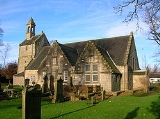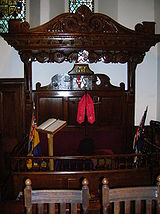
Kilbirnie Auld Kirk
Encyclopedia
Kilbirnie Auld Kirk is a Church of Scotland
congregation on Dalry Road (at Kirkland Road), Kilbirnie
, North Ayrshire
, Scotland
. Although the building dates back to the 15th century, the present congregation was formed in 1978 by the amalgamation of Glengarnock Parish Church and the The Barony Church.
 Previously known as "The Barony Church", after the barony that had been obtained by John Craufurd of Kilbirnie in 1641, the church is constructed on the site of a 6th-century monastic cell. The monk is believed to have been either Saint Brendan of Clonfert, renowned for his legendary travels, or Saint Birinus, Bishop of Dorchester, who was thought to have limited his missionary work to Wessex
Previously known as "The Barony Church", after the barony that had been obtained by John Craufurd of Kilbirnie in 1641, the church is constructed on the site of a 6th-century monastic cell. The monk is believed to have been either Saint Brendan of Clonfert, renowned for his legendary travels, or Saint Birinus, Bishop of Dorchester, who was thought to have limited his missionary work to Wessex
.
The town of Kilbirnie derives its name from the church; the celtic Cil signifying a church, suffixed by the name of the saint. "Auld Kirk
" in Scots simply means Old Church.
The church has some magnificent fittings, pride of place going to the elaborately detailed Crawford Loft of circa 1705, and to the 17th century sounding board above the pulpit. Many of the windows have been decorated in stained glass.
"Kilbirnie Auld Kirk and Cemetery Walls" are a category 'A' listed historic building.
Church of Scotland
The Church of Scotland, known informally by its Scots language name, the Kirk, is a Presbyterian church, decisively shaped by the Scottish Reformation....
congregation on Dalry Road (at Kirkland Road), Kilbirnie
Kilbirnie
Kilbirnie is a small town of 7280 inhabitants situated in North Ayrshire on the west coast of Scotland...
, North Ayrshire
North Ayrshire
North Ayrshire is one of 32 council areas in Scotland with a population of roughly 136,000 people. It is located in the south-west region of Scotland, and borders the areas of Inverclyde to the north, Renfrewshire to the north-east and East Ayrshire and South Ayrshire to the East and South...
, Scotland
Scotland
Scotland is a country that is part of the United Kingdom. Occupying the northern third of the island of Great Britain, it shares a border with England to the south and is bounded by the North Sea to the east, the Atlantic Ocean to the north and west, and the North Channel and Irish Sea to the...
. Although the building dates back to the 15th century, the present congregation was formed in 1978 by the amalgamation of Glengarnock Parish Church and the The Barony Church.
History

Wessex
The Kingdom of Wessex or Kingdom of the West Saxons was an Anglo-Saxon kingdom of the West Saxons, in South West England, from the 6th century, until the emergence of a united English state in the 10th century, under the Wessex dynasty. It was to be an earldom after Canute the Great's conquest...
.
The town of Kilbirnie derives its name from the church; the celtic Cil signifying a church, suffixed by the name of the saint. "Auld Kirk
Kirk
Kirk can mean "church" in general or the Church of Scotland in particular. Many place names and personal names are also derived from it.-Basic meaning and etymology:...
" in Scots simply means Old Church.
Architecture
The original nave dates from 1470, with a two-stage bell tower added twenty years later. Aisles were added in 1597 for the Cunninghames of Glengarnock and in 1642 for the Crawfords. A transept and new entrance front were added in 1903-05.The church has some magnificent fittings, pride of place going to the elaborately detailed Crawford Loft of circa 1705, and to the 17th century sounding board above the pulpit. Many of the windows have been decorated in stained glass.
"Kilbirnie Auld Kirk and Cemetery Walls" are a category 'A' listed historic building.

